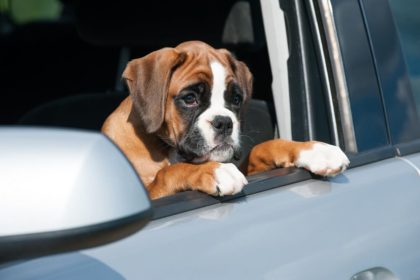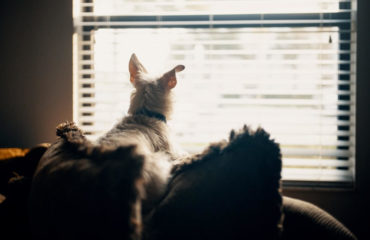How To Travel With Your Dog: Cars & Public Transport

Travelling with your dog can seem like a hassle, but it’s much simpler than you might think when you’re aware of the laws, necessary training, tools you’ll need and the best ways to protect your dog on the move. It’s important to remember that modes of transport which work for one dog, another dog may hate. Just like us, they have their own personalities and need to be respected and accommodated if they are to feel safe in your care. Think of them as little people in furry coats!
To help you on your way to getting out and about for walkies, zoomies and off-road adventures with your fur-babies, read Benchmark Kennels’ tips and advice to ensure happy travelling for you and your dog wherever and whenever you are.
Cars
Travelling in the car with your dog is the easiest option because you can leave your home and jump straight into your vehicle. However, it is subject to strict laws and regulations when compared to travelling on public transport. It may also cause issues if your dog is only willing or comfortable to sit or lay in one part of the car like the boot or footwells due to current Highway Code guidelines.
Read on for all you need to know about safe car travel with your dog.
Follow the law
The laws on travelling with dogs in cars are strict, The Highway Code states that dogs should be secured and restrained so they do not divert your attention from the road and, in the event of an accident, cannot hurt other passengers or themselves.
If you do not follow the rules, you may be charged or fined for dangerous driving and endangerment of lives. Most insurance companies will also require you to secure your dog when you are driving, though it’s advisable to check the terms of your policy with them beforehand.
Protect your dog
In order to protect and secure your dog when you’re on the road one or several of the following safety measures must be installed within your vehicle:
- Crate: Pop their indoor crate onto the back seat of your car, this familiar territory covered in their own scent makes them feel safe, especially good if your dog is an inexperienced traveller. Alternatively, buy a designated travel crate that you can leave in the car and save yourself time and hassle.
- Harness: You can pick up a car harness in a range of sizes from most pet supply shops across the UK, a harness is the most versatile option as it gives you the option to seat your dog with you in the front, the back or in the boot.
- Gate: A gate fits into your boot and prevents your dog from jumping about the car, although it is recommended to keep them crated or harnessed as well, for optimum safety precautions.
Early training
The motion, noise and smell of a car can be extremely distressing for a dog, who just like us, can experience car sickness. In order for your dog to feel happy in the car as they grow older, they should be gradually exposed to it during their early puppy socialisation training. Start with short journeys around your local area and work up to long haul drives for holidays and trips only when your dog is proven to be ready for them.
Tips
- The temperature inside cars can soar in heatwaves, so make sure you open windows for ventilation and provide your dog with drinking water, even if you’re with them the whole time.
- Toilet breaks are just as important for them as for humans making it advisable to stop off every so often if you want to avoid accidents
- Their favourite chew toy and comfort blanket can work wonders for making them feel safe, so don’t forget to bring them along.
- Dogs who suffer from especially severe car sickness should be prescribed specialist medication which can be sourced from your local vet to help both you and your dog have a more relaxing journey.
Public transport
Travelling with your dog on public transport can take you to places you normally cannot reach by car without the potential stress of traffic congestion in highly populated metropolitan areas. For dogs who thrive off action or adventures and aren’t shy of strangers, public transport is a winner. However, if your companion is happier to be alone with you in the car, kept away from frightening noise, a forest of legs and jolting stops, it can take time, patience and practise to familiarise them with public transport’s strange sounds and smells. ,
If you can avoid public transport altogether your dog may be far happier for you to open the hatchback, throw in their favourite toy and head for the open road. If not, read on for all you need to know about travelling on public transport with your dog.
Know your dog
Not all dogs are made for the fast pace and crowds of public transport, that’s why it’s essential to know how your dog might react to unforeseen situations. They might share space with other passengers with dog phobias, young children or allergies, so it’s important to be aware that you are fully responsible for keeping control of your dog when you’re using buses, trains, trams and more.
Your dog should know the following commands:
- Sit
- Lie down
- Wait
- Leave
- Basic recall using their name
It’s not recommended to use public transport with a newly adopted or untrained dog as they are wild animals at heart and can be unpredictable when in unfamiliar or frightening surroundings.
Providing comfort and distraction for your dog is equally impactful, so bringing along a favourite toy, providing plenty of treats and strokes can decrease their travel anxiety significantly.
Bring the essentials
Packing for a day of public travel requires you to plan ahead for a multitude of scenarios, think practically and a lot of minor mishaps can be avoided.
The essentials you’ll need when out and about are:
- Drinking water: Just like car travel, public transport in humid spaces is thirsty work for a dog. Fill up a litre bottle so you can easily pour it into their bowl on the go.
- Food: This is essential if you’re intending to be out of the house during their usual meal times.
- Waste bags: You cannot leave dog waste behind on public transport or anywhere for that matter, therefore you need to take waste bags with you wherever you go.
- Little treats: Treats help to reinforce previous training when commands are obeyed quickly and without fuss. Make sure to give them a little treat as a well done for staying calm and standing by you.
Tips
- Try not to travel on days when the weather is sweltering.
- Keep your dog off seating areas when they’re on public transport.
- Do not let them off the lead in any confined spaces or around strangers.
- Watch out that your dog doesn’t invade the space of other passengers who may not be comfortable around animals or have allergies.
Need a bespoke kennel for your dog when you return home?
Benchmark Kennels are a manufacturer of bespoke dog kennels, giving dog owners of all breed types, sizes and temperaments a secure and spacious place to stay outdoors. Every kennel is custom-made, meaning you can choose the exact size, material, properties and architecture of the kennel itself to ensure it suits your dog and the outside of your property.
You can order a wooden or WPC eco-thermal dog kennel directly from our website today or contact us via phone to find out more about our excellent range of kennels.





You must be logged in to post a comment.